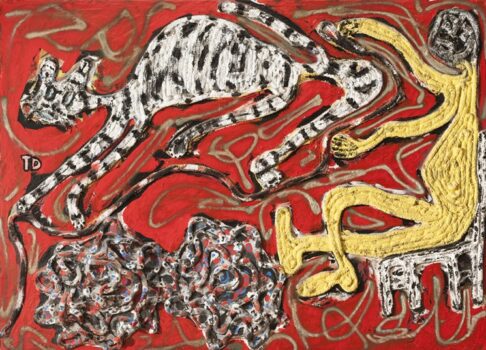What Was Thornton Dial Known For
In the world of contemporary American art, few stories are as compelling, raw, and profoundly moving as that of Thornton Dial. A self-taught artist from the Deep South, Dial rose from the margins of society to become one of the most important and influential outsider artists in American history. His art, a mix of abstraction and narrative figuration, tells stories of struggle, history, identity, and the resilience of the human spirit, particularly from the perspective of the African American experience.
Despite beginning his career as an artist relatively late in life, Dial’s voice came through loud and clear, earning him posthumous acclaim and a rightful place in major museum collections and exhibitions across the globe.
Who Was Thornton Dial?
Thornton Dial (1928–2016) was born in Emelle, Alabama, into a world shaped by the shadows of Jim Crow segregation, racial inequality, and poverty. He never received formal education in the arts, nor did he attend art school. Instead, Dial lived a life steeped in physical labor, primarily as a metalworker at the Pullman Standard Plant in Bessemer, Alabama. He was also a carpenter and construction worker. His lived experiences and deep understanding of material, space, and form would later become the foundation of his distinctive artistic practice.
For much of his life, Dial created art in relative obscurity. He started making “yard art” and sculptures from discarded objects and materials, assembling them into expressive pieces that commented on American society, history, race, war, gender, and spirituality. His works remained largely unseen by the public until the late 1980s, when William Arnett, a passionate collector and advocate for Southern self-taught artists, discovered Dial’s work and began promoting it.
This moment marked a turning point. Dial’s work began to be exhibited in prestigious galleries and museums, eventually gaining critical acclaim not only as “folk” or “outsider” art, but as important, canonical American art.
Thornton Dial was known for his large-scale, mixed-media assemblages that combine painting, drawing, and sculpture. His works often grappled with complex themes such as:
The African American experience and legacy of slavery
Civil rights struggles
War and political injustice
Environmental issues
Human suffering and spiritual redemption
Dial’s pieces are visceral and deeply symbolic. He frequently used discarded and found materials, such as wire, old clothes, rags, wood, metal, and industrial waste, to create highly textured and expressive compositions. This choice of medium not only gave his work a raw, organic quality, but also imbued it with cultural commentary: turning what society deemed “trash” into something powerfully beautiful and meaningful.
His ability to create monumental, museum-worthy art from humble materials is one of the defining aspects of his genius.
How Did Thornton Dial Make His Artwork?
Thornton Dial’s artistic process was deeply intuitive, guided by his tactile sense of form and texture, as well as his philosophical and spiritual insights. He did not sketch his ideas in a traditional sense; instead, he began by assembling objects, anything from bedsprings to chicken wire to cloth, into compositions that became both sculptural and painterly.
Step-by-step Elements of His Process:
Material Collection:
Dial gathered discarded objects from his surroundings, often things thrown away by others in his community. This included metal scraps, furniture parts, plastic, clothing, carpet, animal bones, and more.Assemblage:
He would nail, staple, tie, or weld these materials onto wooden panels or frames. The structure would often be chaotic at first glance, but upon closer inspection, deeply thoughtful and symbolic.Painting:
Dial applied layers of house paint, spray paint, oil, and enamel. His palette was bold, fiery reds, earthy browns, somber blacks, and vibrant blues, which helped emphasize the emotional gravity of his themes.Symbolic Detailing:
Many works contained recurring symbols: the tiger (his personal symbol for the Black man), birds, crosses, fish, chains, and American flags, each adding a layer of meaning.
This raw, expressive process created what many art historians have called a “visual language of resistance and survival.”
What Art Style Is Thornton Dial Associated With?
Thornton Dial is primarily associated with Outsider Art (also known as Art Brut) and Assemblage Art, but categorizing his work solely under these labels does a disservice to its sophistication and cultural relevance.
His art intersects with various movements:
Abstract Expressionism – Through his emotive use of paint and non-traditional forms.
Neo-Dada and Found Object Art – With his use of everyday materials in collage and sculpture.
Folk and Vernacular Art – Because of his self-taught background and deep roots in Southern African American traditions.
Political Art – Due to the explicitly historical and social narratives in his work.
More recently, curators and scholars have advocated for Thornton Dial’s recognition as a major contemporary artist, rather than confining him to the outsider art box.
What Are Thornton Dial’s Most Famous Artworks?
Dial created hundreds of artworks during his lifetime, ranging from large-scale installations to small drawings. Some of his most recognized pieces include:
1. “Don’t Matter How Raggly the Flag, It Still Got to Tie Us Together” (2003)
A powerful piece featuring a tattered American flag made of found fabric and debris. It speaks to national unity despite ongoing racial and political divisions.
2. “The Last Day of Martin Luther King” (1992)
An emotionally charged tribute to Dr. King, combining vivid colors and sculptural elements to reflect on the tragedy and legacy of King’s assassination.
3. “Victory in Iraq” (2004)
An abstract and chaotic assemblage that critiques U.S. military intervention and the human cost of war.
4. “Blood and Meat: Survival for the World” (1992)
This dramatic work incorporates animal bones and industrial scraps, addressing both racial violence and environmental degradation.
5. “Top of the Line (Steel)” (1992)
An intricate piece that reflects his history as a metalworker, representing both industrial strength and the resilience of the working class.
How Many Artworks Did Thornton Dial Create?
It is estimated that Thornton Dial produced over 1,000 artworks during his lifetime, spanning from the early 1980s until his death in 2016. These include:
Mixed-media paintings and assemblages
Sculptures
Drawings and works on paper
Installations
Each piece stands as a powerful testament to his creativity, vision, and ability to turn the everyday into the extraordinary. His prolific output, considering he began his career later in life, is all the more impressive.
What Materials Did Thornton Dial Use?
Thornton Dial’s art is often defined by the innovative and deeply symbolic use of found materials. He believed that everything had a story and potential to be part of a larger narrative. His material choices often reflected both the personal and political.
Common Materials Used:
Metal scraps and wire
Old clothing and fabric
Carpet and furniture padding
Wood and plywood panels
Animal bones and organic materials
Paint: house paint, spray paint, enamel
Plastic, foam, rubber, and industrial detritus
By using these items, Dial embedded layers of meaning into his work. A worn-out shirt could symbolize the laboring class. A piece of barbed wire might reference oppression or the threat of violence. His works are as much about what they’re made of as what they represent.
How Much Does Thornton Dial’s Art Cost?
The value of Thornton Dial’s artwork has risen significantly in recent years, especially after his death and with growing institutional recognition. Prices vary widely depending on the medium, scale, and provenance.
Typical Price Ranges:
Drawings and works on paper: $5,000 to $25,000
Mid-sized mixed-media works: $50,000 to $150,000
Large-scale assemblages and iconic works: $200,000 to $500,000+
Museum-quality masterpieces: Have reached over $500,000, with expectations of crossing $1 million as market demand grows.
Notably, his work has been acquired by major museums, which adds to its long-term market and cultural value. The rise of interest in Black contemporary artists has also driven collectors to seek out Dial’s work as foundational to American art history.
Where Is Thornton Dial’s Artwork Located?
Thornton Dial’s art is now part of major museum collections across the United States and abroad. Thanks to the efforts of the Souls Grown Deep Foundation and collectors like William Arnett, his legacy is preserved and celebrated.
Prominent Locations Featuring Dial’s Work:
The Metropolitan Museum of Art (New York)
The Museum of Modern Art (MoMA, New York)
The Smithsonian American Art Museum (Washington, D.C.)
High Museum of Art (Atlanta)
Birmingham Museum of Art (Alabama)
de Young Museum (San Francisco)
Philadelphia Museum of Art
The Whitney Museum of American Art (New York)
Additionally, his work can be found in private collections, galleries, and periodically in high-profile exhibitions that travel internationally.
The Souls Grown Deep Foundation continues to play a pivotal role in promoting Dial’s legacy, along with other African American artists from the South.
Thornton Dial’s Legacy: More Than an Outsider
Thornton Dial’s journey from a steelworker in Alabama to an internationally respected artist is nothing short of extraordinary. His art transcends simple labels. It is not just “outsider art” or “folk art.” It is American art, bold, uncompromising, and essential.
Dial’s pieces compel us to reconsider what counts as “high” art, who gets to make it, and why. His unfiltered, deeply humanistic approach challenges us to look deeper, at history, at society, and at ourselves.
As interest in self-taught and African American artists continues to grow, Thornton Dial’s position in the canon will only rise. And rightly so. He spoke to the soul of a nation through the discarded objects of its daily life. That is a legacy that will endure.
Thornton Dial’s art is a mirror to America, beautiful and broken, hopeful and haunted. With over 1,000 works crafted from the humble remnants of life in the Deep South, he transformed discarded materials into monuments of meaning. His artworks, now housed in the world’s finest institutions and commanding hundreds of thousands at auction, are testament to the power of vision, truth, and authenticity.
If you ever have a chance to stand in front of a Thornton Dial piece, take it. You won’t just see art, you’ll feel a life’s story speaking through rusted metal, painted cloth, and the indomitable spirit of one of America’s greatest artists. image/snap713/flickr




